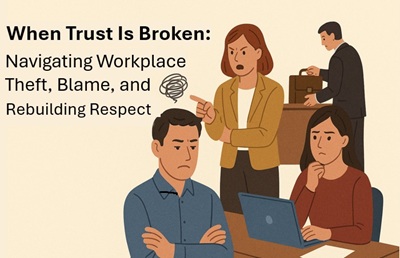
When Trust Is Broken
When Trust Is Broken: Navigating Workplace Theft, Blame, and Rebuilding Respect
Workplace theft doesn’t just hurt the bottom line—it erodes something far more valuable: trust.
Whether it’s missing equipment, misused resources, or confidential data leaks, theft in the workplace creates an emotional ripple effect. Suddenly, a space that once felt safe becomes tense. People start watching their backs, whispers replace open dialogue, and the culture begins to fracture under the weight of suspicion and blame.
But here’s the truth: while theft is an uncomfortable subject, how we respond to it defines whether we spiral into toxicity—or rebuild stronger than before.
The Invisible Cost of Theft: Broken Trust
Theft is more than a policy violation—it’s a breach of social contract. We trust that our colleagues will act with integrity, respect shared spaces, and uphold mutual values. When that’s violated:
- Trust declines: People become guarded and sceptical.
- Blame culture emerges: Accusations replace accountability.
- Morale drops: Good employees feel demotivated and unsupported.
- Productivity suffers: Energy shifts from collaboration to conflict avoidance.
But the challenge isn’t just identifying the wrongdoer—it’s what happens next.
Trust vs. Blame: Choosing the Harder (Better) Path
In environments where theft has occurred, it’s natural to look for someone to blame. But unproven accusations often damage innocent people and deepen divisions.
Instead of fuelling a witch hunt, healthy organizations take a different approach:
1. Investigate with Integrity
A fair, confidential investigation—handled by HR or leadership—is essential. Be clear that due process matters. Avoid public confrontations or gossip-fuelled assumptions.
2. Focus on Systems, Not Just People
Ask: Where did our systems fail? If something was stolen, how was it accessible? Could better inventory control, access restrictions, or transparency have prevented it?
People make choices, yes—but environments can enable or discourage those choices.
3. Communicate with Compassion
Be transparent about what’s happening and affirm your values. Leadership should model composure and reinforce a culture of integrity. Silence fuels rumours—clarity restores direction.
How to Work Well in a Tense Environment
Even if you’re not involved, being part of a workplace where theft and blame are present can feel uncomfortable. Here’s how to protect your peace and professionalism:
1. Maintain Integrity
Let your work and your behaviour speak for you. Show up on time. Communicate clearly. Be generous with credit, honest about mistakes, and consistent with boundaries.
Integrity is contagious and noticeable.
2. Avoid the Gossip Loop
It’s tempting to speculate. But gossip adds fuel to uncertainty and may harm your own reputation. Choose curiosity over conclusions. If it doesn’t involve you directly, don’t spread it.
3. Lean on Values, Not Vibes
If trust feels fragile, return to your personal values. How do you want to be remembered in hard times? Steady, mature, respectful? Or reactive and accusatory?
Your response says more about you than the situation ever could.
4. Speak Up
If you’re feeling uneasy, talk to a manager or HR—not to vent, but to seek clarity. Ask how the company is addressing the issue and what’s being done to rebuild trust. Constructive conversations are better than quiet resentment.
Rebuilding Trust: It Takes All of Us
Trust doesn’t return overnight. It’s rebuilt through:
- Consistent leadership
- Clear communication
- Safe spaces to share concerns
- Collective commitment to shared values
Even after theft, a team can emerge more united if it chooses reflection over retaliation, systems over suspicion, and responsibility over blame.
Final Thoughts
Workplace theft is a hard truth. But the real challenge isn’t the act itself—it’s what we do next. Will we default to blame and suspicion, or choose to rise above and lead with clarity, professionalism, and integrity?
In difficult environments, character stands out. Be the calm, be the anchor, and be the kind of colleague that others feel lucky to work beside—even in the storm. By Ashlene Moyo



